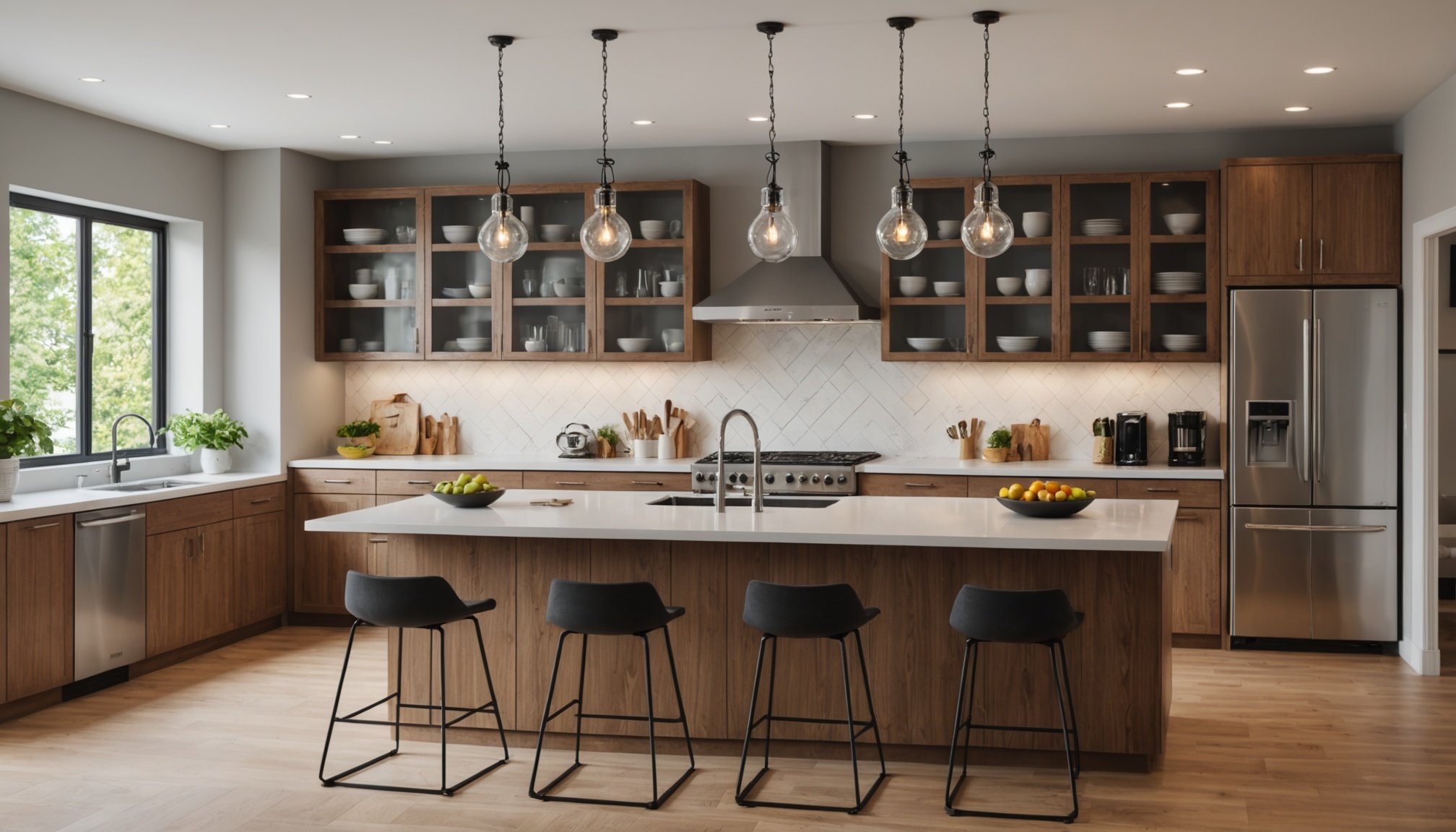Overview of Acoustic Panels
Acoustic panels are designed to manage sound by absorbing noise and reducing echo in home environments. These panels are particularly useful in spaces like the kitchen, where noise from appliances and conversations can lead to an overwhelming auditory experience. Managing sound efficiently in the kitchen is crucial as it enhances communication and creates a more pleasant environment.
Various materials are used to construct acoustic panels, each contributing to different levels of noise reduction. Common materials include foam, fabric, and wood, each chosen for its ability to absorb sound effectively. Foam panels are lightweight and easy to install, making them a popular choice for DIY installations. Fabric panels, often aesthetically pleasing, can be customised to match the kitchen design, providing both functionality and style. Wood panels, while heavier, offer a more robust solution for sound management.
Also to see : Boost your meal prep: how kitchen island positioning enhances healthy cooking efficiency
Different types of acoustic panels are available to suit varying kitchen needs. For instance, wall-mounted and ceiling panels are ideal for small kitchens struggling with space constraints, whereas freestanding panels can be repositioned as needed, catering to dynamic kitchen layouts. By carefully selecting appropriate acoustic panels, homeowners can substantially improve their kitchen’s acoustics while complementing its overall design.
Placement Strategies for Acoustic Panels
Achieving optimal kitchen acoustics involves strategic panel placement. In a bustling kitchen, noise often stems from high-noise areas such as appliances, cooking zones, and areas with frequent foot traffic. To manage sound effectively, consider these placement strategies.
In parallel : Revamp your culinary space: unlock healthier eating habits with a smart waste sorting system
Effective Placement in Workflow: Arrange acoustic panels in locations where noise is most pronounced. Position panels near appliances and prep areas, ensuring they do not interfere with the kitchen workflow. This strategic placement helps in reducing noise reflection and creating a more pleasant environment.
Ceiling and Wall Panels: Both play a critical role in sound absorption. Ceiling panels are particularly effective as they capture noise rising from below and diffuse it evenly. Wall panels are versatile and can be positioned at ear level to enhance their efficacy. When arranged together, they create a cohesive solution for sound management.
Integration with Decor: The aesthetic appeal should not be compromised when integrating panels. Consider choosing panels that blend seamlessly with existing kitchen decor. Panels come in various colours and finishes, allowing them to complement or enhance the kitchen’s overall style. This integration ensures a harmonious balance between functionality and design.
Psychological Benefits of Acoustic Panels in the Kitchen
The kitchen, often the heart of the home, is not just a place for cooking but a space for gathering and connection. Sound plays a significant role in shaping this environment, influencing mental health and overall well-being. Studies show that a well-managed sound environment can drastically reduce stress, particularly during meal preparation. By minimizing noise, people experience less distraction, leading to a more peaceful and concentrated cooking experience.
An optimal sound setting can promote healthier eating habits. When noise levels are kept in check, individuals are more likely to savour their meals, eat at a calmer pace, and enjoy the social aspects of dining. This noise control enhances the mealtime experience, promoting mindful eating.
Case studies have highlighted the transformative effects of integrating acoustic panels in kitchen spaces. Families report a noticeable stress reduction, with increased satisfaction in both cooking and dining activities. These panels effectively absorb unwanted sound, fostering an environment ripe for relaxation and enjoyment.
By incorporating acoustic solutions, kitchens become not only a hub for culinary creativity but also a sanctuary for mental rejuvenation, illustrating the profound yet subtle influence sound has on everyday life.
Practical Installation Tips for Acoustic Panels
Installing acoustic panels in your kitchen can be a satisfying DIY project, enhancing both aesthetics and sound quality. This installation guide will lead you through a straightforward process.
Step-by-Step Guide to Panel Setup
- Preparation: Begin by measuring your kitchen’s surfaces to determine how many panels you’ll need.
- Materials: Gather essential tools like a level, tape measure, pencil, and mounting strips. Ensure that your panels are made of quality sound-absorbing material for optimal performance.
- Placement: Strategically place panels where sound reflection is most evident, such as opposite walls and ceilings above noisy appliances.
Tools and Materials Needed
For a seamless panel setup, you must have:
- A reliable pair of scissors or a utility knife for trimming materials.
- Adhesive or screws, depending on the mounting method.
- A drill may be necessary if panels are particularly heavy.
Common Mistakes to Avoid
Avoid these common mistakes to ensure a successful installation:
- Improper Alignment: Always use a level to ensure panels are straight.
- Inadequate Adhesion: Ensure surfaces are clean before attaching panels to avoid them peeling off.
- Overlooking Acoustics: Place panels strategically, focusing on areas where sounds bounce most prominently.
Real-Life Examples of Successful Acoustic Panel Use
Acoustic panels have transformed numerous kitchens, offering practical solutions to manage sound challenges effectively. Here, we explore case studies of individuals who successfully integrated these panels into their kitchen design.
Many homeowners reported significant changes in their kitchen ambiance, sharing their user experiences candidly in interviews. They noted improved sound quality and a more pleasant environment for family gatherings or entertaining friends.
For instance, one homeowner described their kitchen transformation, focusing on how the installation reduced echo and improved conversation dynamics. This aligns with others’ experiences where before-and-after scenarios depicted a shift from noisy, chaotic settings to calm, harmonious spaces.
To ensure these results, expert insights are crucial. Specialists stress that selecting the right type and placement of acoustic panels is key. In kitchens, this often means using panels strategically on walls or ceilings to maximize sound absorption without sacrificing style.
Feedback from these transformations emphasizes not only the functional benefits but also an enhanced aesthetic appeal. Acoustic panels blend seamlessly, proving effective in addressing sound issues while maintaining the design integrity of the kitchen. This holistic approach ensures kitchens remain inviting and conducive to social interaction.











